
Entering the European fishing tourism market
The fishing tourism niche market is all about off-the-beaten-track and adventure fishing holidays that incorporate local culture. Sustainability, conservation, and health and safety are important elements of fishing tourism. Guides who are knowledgeable and experienced are key to finding the species anglers want to fish. They use a range of different booking methods, the main being specialist European tour operators and the online travel agency (OTA) Fishingbooker.com. Top destinations for this niche include Mexico, Guyana, Kenya and the Bahamas.
Contents of this page
- What requirements and certifications must fishing tourism meet to be allowed on the European market?
- Through which channels can you get fishing tourism on the European market?
- What competition do you face on the European fishing tourism market?
- What are the prices of fishing tourism on the European market?
1. What requirements and certifications must fishing tourism meet to be allowed on the European market?
The European tour operator market must comply by law with several regulations to ensure travelling clients are safe and are protected financially. To do business with the European market, you must align your business processes with theirs to meet their expectations. European tour operators expect you to meet conditions set in a Code of Conduct and/or Terms of Business. Sustainability in all areas of tourism provision is essential for all European tourism suppliers. You must include sustainable actions throughout all your business activities.
What are the mandatory and additional requirements that buyers have?
The mandatory and additional requirements for fishing tourism services are standard across the sector. They include:
- The European Package Travel Directive
- General Data Protection Regulation (GDPR)
- Liability Insurance and Insolvency Protection
You can find out about them in CBI’s What are requirements for tourism services in the European market?. The study will help you understand the legal, non-legal and standard requirements that European tour operators must comply with. If you know the requirements they are bound by and can adapt your business to meet their needs, they are more likely to do business with you. It is essential to European buyers that they can trust their suppliers to meet their and their customers’ needs.
What are the requirements for niche markets?
International recreational fishing trips are on the rise as travellers seek more adventure and travel to remote locations and destinations. There are key requirements for local tour operators to cater to this market. Sustainability and conservation are high priorities for tourists, alongside requirements around health and safety, knowledgeable guides, and high-quality boats and equipment. Tour operators and experienced providers need to be flexible and offer unique and bespoke experiences.
Embed sustainability and conservation throughout your operations
Running a sustainable operation is important for both customers and tour operators. It can support local conservation efforts while increasing customer experience and satisfaction rates. Ensuring your operations positively impact the local environment, people and places is essential. Anglers look for sustainable businesses when undertaking research for their holiday.
Recreational fishing activities have become more scrutinised due to issues around sustainability and conservation. In some destinations, fishing has caused species to become nearly extinct. In Guyana, a study found the freshwater arapaima faced extinction from overfishing. Conservation efforts by local communities have turned this around and today populations have increased all over the Amazon region.
Local and regional governments have enhanced regulations around catch-and-release rules. Kenya has strict regulations for billfish fishing because of conservation concerns, and operators are required to release them when caught. The publication WWF Principles for Sustainable Fishing Tourism outlines sustainability principles and the benefits to communities.
Mexico enforces strict fishing regulations, requiring all boats, crew members and passengers to be licensed, regardless of whether they are actively fishing. Each person is allowed only one rod or line in the water, and there are restrictions on the number of rods and reels that can be brought onboard. Marine species like molluscs, crustaceans and turtles are protected by law. Additionally, there are limits on the quantity of fish that can be caught and kept, while catch-and-release activities are not restricted.
Figure 1: A fishing operator’s sustainability statement

Source: Wild Kenya Safaris, 2024
Tourism can support conservation efforts through tagging of fish when caught to help track their movements and make future efforts to help the fish flourish. Income streams through tourism can also contribute towards conservation efforts, research and other initiatives that help conserve specific species. Employing members of the local communities can also support conservation efforts by creating additional income streams and taking away the reliance on fishing for their own consumption and for selling locally.
Catch-and-release efforts do not always work. Specific devices help support a fish’s chances of survival, like barbless hooks, which make it easier to release the fish without injury. The Nature Conservancy’s Deck to Depth initiative promotes using descending devices to reduce the mortality rate of fish being released back into the water. Different devices are available on the market, so find out which ones are best for the species you are catching.
Figure 2: Example of a descending device
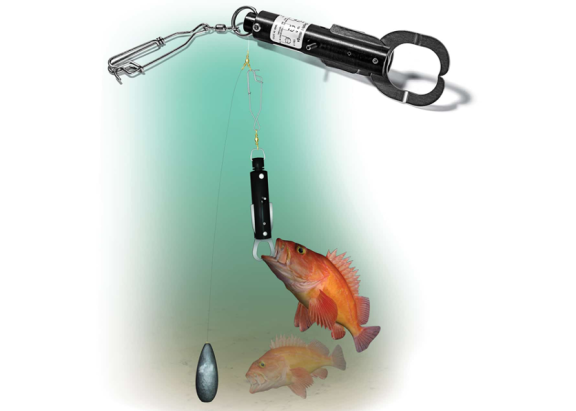
Source: Sport Fishing Mag, 2015
There are different techniques to help reduce trauma from capture. It is crucial to ensure you have researched and understood these to minimise harm. Educate your guests on the correct handling strategies and why they are essential. More information on these can be found in this blog by Yellow Knife Sportfishing.
The best way to highlight your sustainability efforts is to be transparent on your website about your initiatives and future goals. Certification can also help distinguish yourself from others. Several certification schemes available for tour operators, like TourCert, Good Travel Seal and Travelife, are worth considering.
Boat- or fishing-specific certifications include:
- The Marine Stewardship Council Certification
- Blue Flag Certification – for sustainable boat operators
- Friends of the Sea – for sustainable fisheries and fleets
Some destinations run local certification schemes, so check with your national tourism board for these initiatives and whether they would suit your operations. Costa Rica and Kenya are good examples where the national tourism boards have developed their local standards for sustainability. Both are also recognised by international standards from the GSTC.
More information on certifications and how to run a green business can be found in the following reports:
- How to be a sustainable tourism business
- 10 tips to go green in the tourism sector
- 9 tips on how to become more socially responsible in the tourism sector
The infographic below highlights specific initiatives and activities fishing tourism businesses can undertake.
Figure 3: Fishing tour operators’ sustainability practices
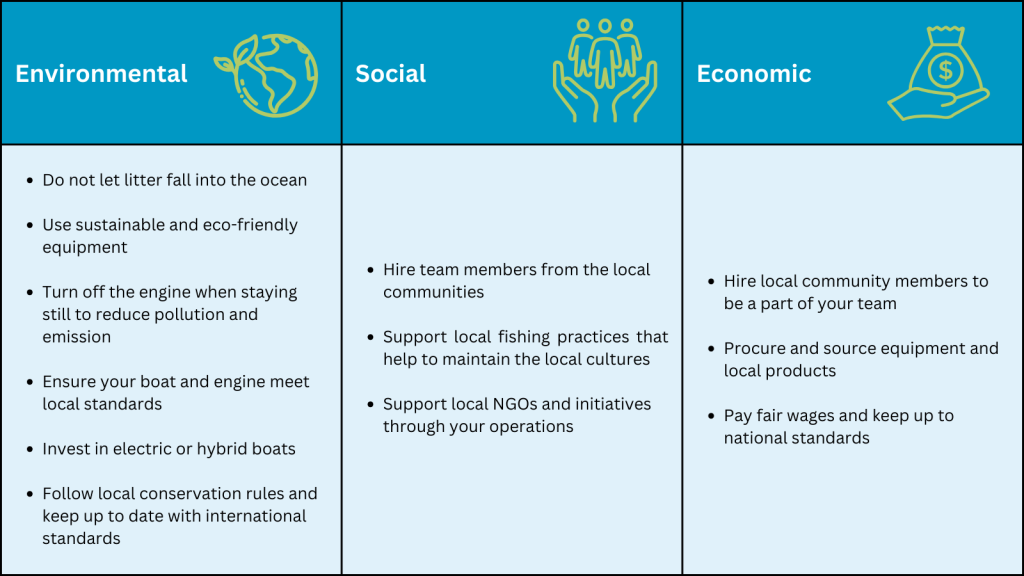
Source: Acorn Tourism Consulting, 2024
Tips:
- Review the WWF Principles for Sustainable Fishing Tourism for more details and support with increasing the positive impacts of your operations.
- Stay informed on conservation-related local regulations. You can do this by joining local associations and supporting conservation initiatives.
- Invest in new technology and equipment that supports sustainable fishing and understand the needs of different fish species.
- Educate guests about sustainability and conservation issues and your organisation’s efforts to overcome these. Have a section on your website that explains your actions, like African Waters.
- Make sure to help your guests apply for any licences that are required.
Requirement for suitable and plentiful fish species
Fishing tourists may pick a destination based on the fish species available. Since these tourists have varying interests, you must know what’s available depending on the time of year. Tourists will not want to travel to the destination with a minimal chance of catching a specific fish. Consider including a page on your website, like the example below.
Figure 4: Best time to fish in Cabo San Lucas
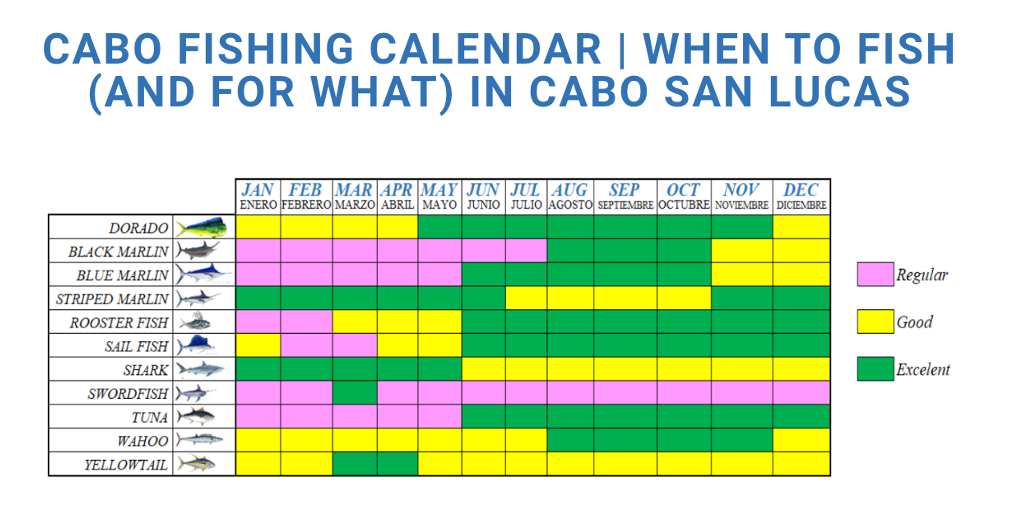
Source: Cabo Fishing, 2024
Keeping clients informed and updated on catches through blog posts can be an exciting feature that helps engage prospective tourists: Baja Adventure Co. does this; similarly, CR Fishing Charters updates clients through daily reporting of all that is caught within the local area, as seen below.
Figure 5: Daily fishing reports for Costa Rica
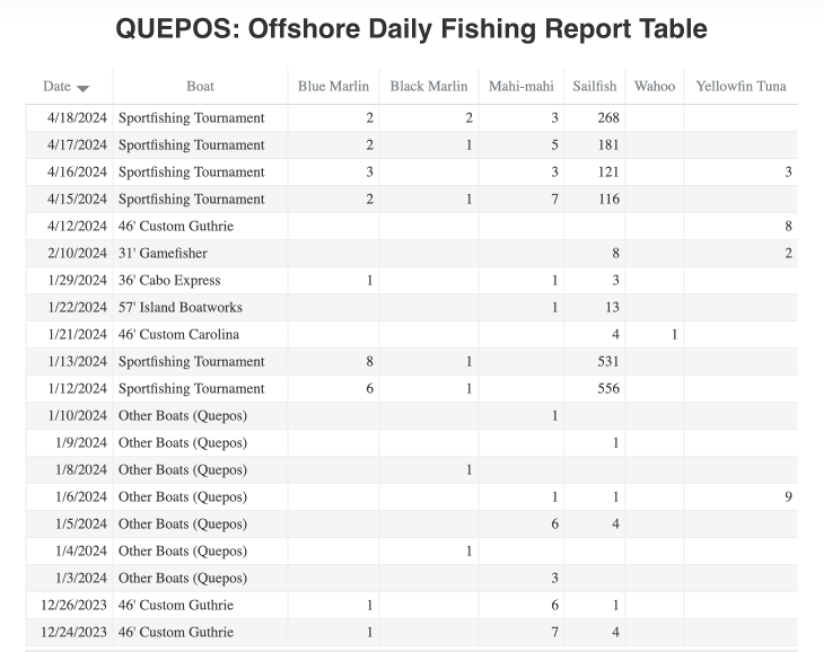
Source: CR Fishing Charters, 2024
Tips:
- Record and keep track of every fish that is caught so you can publish it on your website.
- Create an interactive or easy-to-read table or infographic displaying what fish can be caught for the month.
Provide experienced, trained and knowledgeable guides
Various abilities and knowledge will determine the types of tourists who partake in fishing experiences. The most experienced and keen anglers will be well-informed about the sport. Having well-trained and knowledgeable guides who can lead trips for this array of abilities is important.
Fishing guides should be competent and professional. If specific fishing guide training is not available or required locally, general guide training can be provided. Have a look at the Belize National Tour Guide Training Program, developed by the National Tourism Board.
Hiring local fishers from the local community will support local employment. They know which fish are local and where they can be found, and have the expert knowledge required for leading fishing charters. This will also help provide guests with authentic experiences.
Fishing can be dangerous, especially when using specialist equipment and in deep water. Tour guides should undergo health & safety and CPR (cardiopulmonary resuscitation) training, including refresher courses, on an annual basis. Some destinations or tour operator partners may require this. Check local legislation and stay updated.
Figure 6: Health and safety information

Source: The Crazy Bahamian, 2024
Before fish are released back into the water, anglers often like to take high-quality photographs of their catch. It is helpful if the guide has a camera and can take professional pictures to share with the client. You can also use these images on your own website and social media pages.
Figure 7: Anglers like to show off their catch
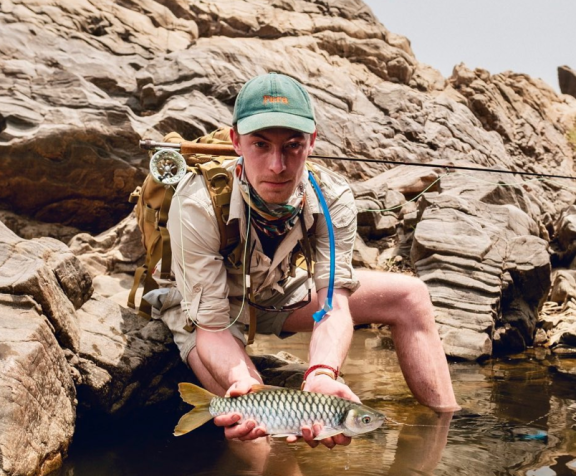
Source: Instagram: Meade Fishing, 2023
Tips:
- Ensure your guides are registered and comply with local laws and regulations. If necessary, undertake yearly training to ensure your guides stay updated on health and safety measures.
- Look out for local guiding courses and encourage them to enrol.
- Employ members of the community who know the waters and environmental conditions well and will be able to provide guests with an authentic experience.
- Ensure guides are wearing their kill cord as a safety measure at all points when driving the vessel. Be sure to watch the video, which clearly shows the importance of kill cords.
Use safe and well-equipped boats
European tourists and tour operators are very health- and safety-conscious. Your guides must be trained and boats must meet international standards. Some destinations may require the boat captain and crew members to obtain and hold a boating licence. This training will include modules around boat safety. If this is not a local requirement, consider building a yearly course to update your guides and team.
Ensuring guests have life jackets that meet international standards is important. You should encourage all guests to always wear their life jackets, even if it is not a legal requirement. Other equipment, such as flares, fire buckets and fire extinguishers, must be on board. You can check the rules on the necessary equipment for British pleasure vessels.
Technology is also becoming increasingly important and useful for anglers. New systems that help track swarms of fish under the water and equipment such as fish finders, drones and GPS navigation systems are more common these days. In areas where it can be challenging to locate the best fishing locations, these systems can help provide your guests with a better experience and higher chances of a catch.
Figure 8: Fishing charter boat features
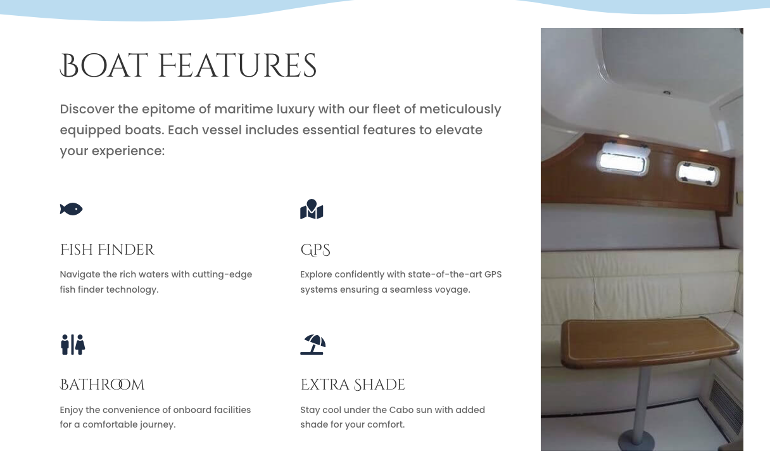
Source: Fishing 4 Cabo, 2024
Guests may spend all day fishing at sea, so ensure the boat is comfortable and has features like a bathroom, cabin and shaded area. Cool boxes and other equipment to help store cool refreshments and meals will enhance your guests’ experience.
Tips:
- Check the RYA website’s safety section, which has up-to-date information on requirements and equipment needed to ensure the safety of your guests and crew members.
- Find out if there are local or national regulations that your boats and equipment must meet.
Provide a range of equipment and bait to hire and/or purchase
European fishing tourists will most likely have had to travel by plane to reach their destination. On domestic and international flights, weight limits are common. This may result in anglers being unable to bring all their fishing gear with them. You should provide equipment for hire or to borrow. A weighing or measurement device is also vital for anglers to determine the length or weight of their catch. This can be one of the most critical factors that anglers want to know as they try to beat records.
Be transparent about what you can provide and what you cannot – for example, Loop Tackle provides a list on their website.
Figure 9: A list of required equipment
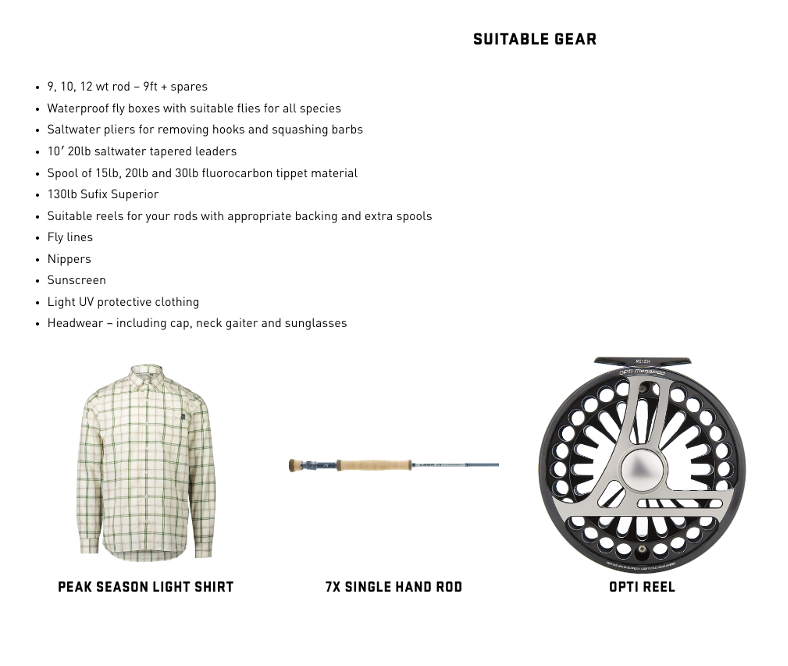
Source: Loop Tackle, 2024
Be flexible and build itineraries that reflect nature and adventure
European tourists are increasingly seeking unique and customised nature-based experiences in off-the-beaten-track locations. Fishing operators can respond to these wishes by creating flexible experiences that take tourists to quiet places, away from other tourists. They may also hire local fishers as their guides to share their knowledge of the local customs and cultures alongside knowledge on fishing locations and tactics.
Incorporating other experiences into your fishing packages is a way to attract the adventure tourist market. You may visit a local fishing village and eat lunch cooked by the community, or hike up a nearby mountain to take in ocean or lake views.
Figure 10: Examples of unique fishing experiences
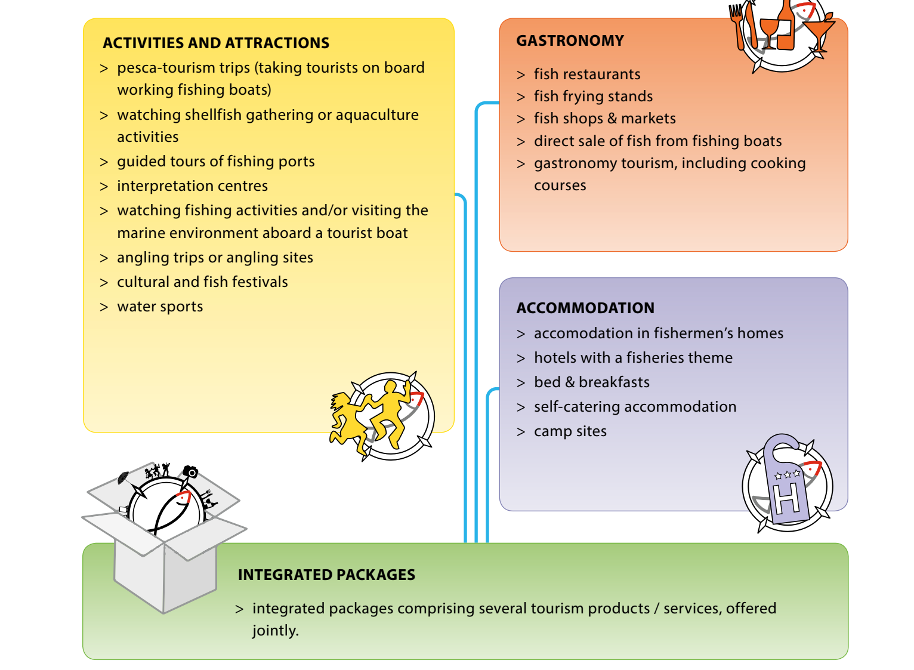
Source: FARNET Guide, 2013
Tips:
- Incorporate local nature-based and cultural experiences, such as trips to remote areas and visits to local communities, into your itineraries.
- Hire local fishers as your guides.
- Find more remote locations that are least popular with other local operators and tourists but are known for good fishing opportunities.
2. Through which channels can you get fishing tourism on the European market?
The fishing tourism niche is varied when it comes to sales channels. It depends on the product offering and the length of the experience. Specialist tour operators and OTAs are the best place to start, followed by adventure-based tour operators. Connecting with local destination management companies (DMCs) and other suppliers can also be effective.
How is the end market segmented?
Anglers that take part in fishing tourism are all quite individual and have different preferences based on fish species, fishing techniques, people they fish with, destinations and so on. The chart below shows the wide range of angler types.
Table 1: Angler Types
| Angler Types | Primary Motivation (in priority order) | Size of Market | ||
| Adventurous Angler | This thrill and challenge of fishing | I want an outdoor activity that connects with me | I am fascinated by fish | 18% |
| Zen Angler | Get away and relax | n/a | n/a | 18% |
| Friendly Fisher | Connecting with family or friends | Spending time outdoors | Get away and relax | 16% |
| Consumptive Angler | Catching fish for food | Fishing is a tradition that was passed down to me | I want an outdoor activity that connects with me | 12% |
| Social Dabbler | Connecting with family or friend | n/a | n/a | 12% |
Occasional Angler | To meet a challenge | n/a | n/a | 13% |
| Traditionalist | Passing on my love of fishing to others | Being part of conservation efforts | Fishing is a tradition that was passed down to me | 11% |
Source: Southwick Associates, 2020
For more information on the segmentation of the angling market, consult the CBI study What are the opportunities on the European fishing tourism market.
Through which channels does a product land on the end market?
Tour operators and OTAs are popular sales channels for fishing products. There are several operators that specialise in fishing holidays. Connecting with local DMCs can also help boost your sales. DMCs work closely with international outbound tour operators and travel agencies to provide local knowledge and book and plan the entire trip.
Direct sales channels, including your website and social media channels, can be important. The process is outlined in the chart below.
Figure 11: Sales process of fishing products to the European market

Source: Acorn Tourism Consulting, 2024
Each channel is further outlined below:
Management destination companies (DMCs): DMCs sell inbound travel and often act as intermediaries between European tour operators. They provide local knowledge and make good connections and relationships with local suppliers. Some DMCs selling fishing experiences as part of their packages are Costa Rica DMC, Maritur DMC (Mexico), Beyond the Plains (Kenya), Total India DMC and 1 DMC World (Guyana).
European Tour Operators: Specialist fishing-focused tour operators operate in the key outbound European markets, along with many more generalist operators who sell fishing as part of their holidays or as an additional experience.
- Specialist Fishing Tour Operators: World’s Best Fishing Trips (Netherlands), DHD-LAÏKA (France), Where Wise Men Fish (UK), Fish Travel (UK), World Sport Fishing (UK), Sport Quest Holidays (UK), Go Fishing Worldwide (UK), Andrees Angelreisen (Germany), Go to Fish (Italy), Viaggi di Pesca (Italy), Loop Tackle (Sweden).
- General Tour Operators: Safari World (France), Scott Dunn (UK), Coral Tree Travel (UK), Abenteur (Germany), Afro Caribbean Travel (Sweden).
Online travel agencies (OTAs): There is one OTA for fishing holidays and experiences, Fishing Booker, with over 46,000 experiences listed on its platform in over 110 countries. A few fishing brands also sell trips as an extra, like Orvis. Many general OTAs, like Viator, SafariBookings and Responsible Travel, sell fishing experiences.
Direct sales: When catering to travellers who tend to book directly with local activity providers, having a well-designed and functioning website and social media platforms is very important. This market will likely return to the same provider and recommend options to friends and family.
Other ways to reach the fishing market
There are many ways to reach the fishing tourism market. As a popular niche in Europe with increasing interest, there are lots of events, forums, publications, associations and clubs.
In addition to social media platforms like Instagram, TikTok and Facebook, the fishing community relies heavily on recommendations from other anglers. Online forums like World Sea Fishing are popular when looking for suggestions and feedback. There is also a proliferation of fishing influencers, like Fish With Carl, Meade Fishing and Mark Pitchers.
Trade shows can be an excellent method to market your experiences directly to the consumer. They allow you to meet anglers and sell your product to them face-to-face. Such trade shows in Europe include the European Fishing Tackle Trade Exhibition (EFTTEX) and The Big One Show (UK). The following links can be used to find fishing-related trade shows in the top European outbound markets: Italy, Germany, United Kingdom, Sweden and France.
Magazines and online forums are good ways to reach the sport fishing market, through sponsorship, paid advertising, or an article written to promote your services and destination. For example:
Magazines:
- Angling Times: reviews and advice for sport fishing enthusiasts.
- Field and Stream: considered one of the best fishing magazines around.
- Fly Fisherman Magazine: offers tips for beginners and experts.
- In-Fisherman: includes a destination section and an In-Fisherman TV channel.
- Marlin Magazine: big-game fishing content with a travel section.
- Saltwater Sportsman: concentrates on saltwater fishing and has a small travel section.
- Sport Fishing: includes a travel section and sport fishing TV featuring key sport fishing destinations.
Online forums:
- Fish Track: fishing charts, reports, cams and a mobile app worldwide to find fish.
- Fishbrain: has amassed names and images of more than 43,000 types of bait and logged 75,000 catches. 95% of data is uploaded via the mobile app rather than the website. Users are predominantly from North America, Sweden and Australia.
- Fishing TV: entertainment platform for anglers. Four free-to-view channels plus added extras for members. Includes the Game Fisher’s Diary, which features worldwide fishing destinations.
- World Sea Fishing: online forum community dedicated to fishing and boat owners (87.8k members).
Associations and Clubs are important too. They have members who are likely to travel abroad on fishing holidays. Therefore, either joining these or finding a means of engaging with their members can be important.
- European Fishing Tackle Trade Association (EFTTA): supports the fishing tackle trade industry in promoting sport fishing.
- Fly Fishers International: publishes its own magazine, Flyfisher.
- Take Me Fishing: the site of the Recreational Boating and Fishing Foundation (RBFF), whose mission is to increase participation in recreational angling and boating and thereby raise public awareness and appreciation of the need to protect, conserve and restore natural aquatic resources.
- The Angling Trust: a single organisation representing all game, coarse and sea anglers, and angling in England.
Tips:
- Use these resources to stay abreast of market trends, equipment updates, and other vital information to help you better serve the European fishing market.
- Connect with local accommodation providers to promote your trips. Many hotels, hostels and lodges may allow leaflets and/or other marketing materials to be displayed inside their property.
- Use high-quality videos and photos when marketing your product through these platforms to help you stand out from your competitors.
- Ensure your independent marketing efforts are current and active. This includes email communication, social media platforms, travel review sites (e.g. Tripadvisor) and destination management organisation websites.
- Read this CBI study to help build or update your website: How to be a successful tourism business online?
What is the most interesting channel for you?
Tour operators and OTAs, whether they specialise in fishing or not, are the most popular sales channels. Make sure you research fishing specialist and more general adventure-based tour operators in your target outbound markets.
Booking online is a rising trend in the European market, owing to its ease. Make sure you are listed on OTAs to help increase your bookings. Check which are the best ones for fishing experiences and your target markets. Working with OTAs can be slow to start with, but once you have a couple of bookings and good reviews things may take off. The CBI study How to effectively work with OTAs is a helpful tool.
As fishing experiences require well-trained and licenced team and crew members, DMCs and local tour operators are likely to rely on external suppliers. Make sure to connect with local DMCs to promote your offering, and advertise why you are different from other local operators.
3. What competition do you face on the European fishing tourism market?
Many destinations worldwide are popular for anglers. The choice will depend on the type of fishing experience and market segment. Sport fishing is most popular in coastal areas where the weather is good and the seas are calm. Fly anglers will fish on lakes and rivers, in more remote locations.
The choice of destination will also depend on the species of fish that the angler is looking for and the time of year. The ability to catch certain fish species changes throughout the year, specifically for deep-sea fishing.
Which countries are you competing with?
Mexico, the Bahamas, Kenya and Guyana are amongst the most popular destinations for anglers worldwide thanks to the fish species available in their salt and fresh waters. Other competing destinations are India, Costa Rica, Zimbabwe, Belize, Panama and Vietnam.
Mexico
Mexico offers some of the top sports fishing in the world. Deep-sea fishing is the most popular activity in Mexico, surf and fly fishing are alternative options. Top locations for fishing include Los Cabos, famous for its marlin and sailfish. Mazatlán, one of the country’s most popular coastal resorts, is known as the ‘billfish capital of the world’. Other top destinations are Puerto Vallarta, Costalegre, Zihuatanejo, Acapulco and Cancún.
Sports fishing in Mexico is usually a half-day or full-day activity that leaves early in the morning. Most operators are well-equipped with boats adapted for the sport. The best saltwater fish to catch are roosterfish, bonefish, tarpon, snapper, tuna, and there are many more. Good options for inland freshwater fishing are bass, trout and catfish.
Mexico has strict regulations on conservation and sustainability of the fishing industry. Most operators in the country follow catch-and-release practices, and all crew members and tourists must be licensed. There are also regulations on the number of fish caught by sport fishers. For example, no fisher can catch more than five fish of any species per day. Find out more about sportfishing licences in Mexico.
Figure 12: Landing a catch at Baja California, Mexico
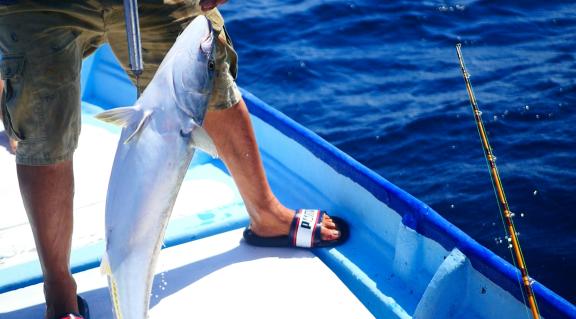
Source: Cast & Spear at Unsplash, 2020
The Bahamas
The Bahamas have 16 islands and a crisp blue ocean that boasts a wide range of fish species. With everything from marlin to bonefish, anglers can fish 365 days a year. The calm waters of the Bahamas offer three types of fishing: deep-sea fishing, where you can catch marlin, sailfish, tuna and dolphin; reef fishing, which allows for grouper, tiger fish and snapper; and fly fishing, for bonefish, permit and tarpon.
The Bahamas Tourism Board promotes fishing activities to boost tourist numbers. Its website also has a page explaining the fishing regulations, a list of lodges and charters, and where to apply for a permit. The Bahamas is home to 50+ record-setting catches and hosts several world-famous fishing tournaments, including the Bimini Native Fishing Tournament, which is about to celebrate its 74th anniversary.
Guyana
Guyana has a reputation as an eco-tourism destination that offers true off-the-beaten-track adventures. Fishing is popular on the Essequibo River, which is unexplored. Local indigenous guides lead the trips, taking tourists into the jungle with the chance to catch over 900 species of fish, including peacock bass, arapaima and wolf fish. The best fishing months are between September and April, when water levels are high.
Guyana has strict catch-and-release rules. In the early 2000s the most popular fish, the arapaima, the world’s largest freshwater fish, was near extinction due to overfishing on the river. Alongside the National Tourism Board and local indigenous communities, a framework for community-led tourism was developed to support the conservation of the species. In 2023, Guyana won the Green Destinations Top 100 Stories award for their positive work.
Multi-day trips are popular due to the remoteness of the best fishing locations along the river. Tourists experience local culture, food and nature during their journey. They usually camp or stay in basic lodges along the way.
Figure 13: Guyana Arapaima
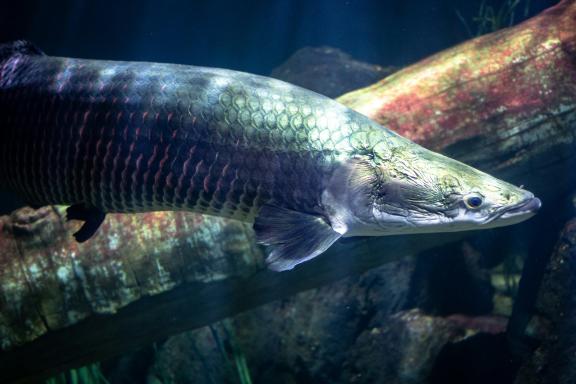
Source: : Joshua J. Cotten, Unsplash, 2019
Kenya
Kenya is best known as a safari and beach destination, and has gained a reputation for being Africa’s top sports fishing destination. From mountain lakes to the Indian Ocean, it offers many opportunities for experienced and novice anglers. Top locations for deep-sea fishing include Lamu, Diani and Mombasa Island. Here anglers can expect to catch giant trevally, mahi mahi, yellowfin, wahoo and barracuda. July to March are the best months for offshore fishing.
Onshore fishing takes place in mountain rivers and lakes. These remote locations provide anglers with a nature-based, wild experiences different from what the ocean offers: Mount Kenya offers many spots that are popular for trout fishing; and in Lake Turkana, in the middle of the Kenyan desert, you can find tilapia, Nile perch and tiger fish.
Currently, fishing experiences are added as an additional experience for tourists. Many will climb Mount Kenya or go on safari before heading to the coast for relaxation and sea-based activities.
Key Takeaways:
- Find out about local regulations on conservation and catch-and-release rules.
- If permits are required, support your guests with the application process and any other regulations that need to be followed.
- Work with your national or regional tourism boards to ensure your operation is listed as a supplier on their websites.
- Make it clear on your website what months are best for which fish.
Hire local guides that have a good understanding of the local waters and can provide the best immersive experience.
Which companies are you competing with?
Local tour operators that attract the fishing tourism market range from small family run businesses that only offer fishing experiences to larger operators offering a range of adventure activities that include fishing. This section provides information on both types within the top destinations profiled in the previous section.
Mexico
Baja Adventure Co is an eco-friendly adventure tour operator based in Southern Baja. Fishing is the main activity offered, alongside shore adventures that might attract non-fishing companions. They have a range of boats that can be chartered. All have been adapted for fishing in the local seas and fitted with eco-friendly engines to help combat climate change.
They cater to all types of travellers, whether individuals, families, or groups of friends. Their activities can be customised and adapted to the angler’s competence level. Their up-to-date and modern website provides clients with all the information they may require. This includes a fishing report section highlighting what species have been caught recently, an essential marketing tool to attract new anglers to a destination.
Fly Fish Mex runs guided fishing trips in the East Cape of Baja, Mexico. Their user-friendly website provides guests with all the required information. This includes an interactive fishing calendar where one can click on each fish species and check which months are the best. They have a professional Instagram account where they regularly upload images and posts to promote their experiences. They have over 3,000 followers and post a range of high-quality photographs and videos.
The Bahamas
Crazy Bahamian is a small locally owned father-and-son team. Their website is simple and user-friendly, and highlights their main offerings. It also describes the team and their experience. This includes detailed information on the importance of the health and safety of guests and features the team’s training and certifications. Information can also be found on life jackets and equipment they will provide.
Additionally, the website has a link so guests can book instantly and directly with the operator. This helps with customer experience and quicker turnarounds from enquiry to booking. They use the booking platform Resova, which is linked to their site.
Fly Fishing Nassau is a small fishing charter experience provider offering additional activities like swimming with pigs and sunset cruises. Their well-equipped boat includes life jackets and a first-aid kit. Their website highlights the importance and awareness of sustainability and conservation issues. It details the local regulations and how they operate to follow these. At the bottom of the page they provide the link to apply for a flats fishing licence.
Fishbone Tours offers a variety of experiences for all fishing abilities and ages. They have worked well to gain positive reviews on Tripadvisor, which they promote through links on their website. They have also partnered with Cape Eleuthera Institute to support their turtle research programme. If a turtle is caught and brought onto the boat, it is measured, photographed and tagged to support conservation efforts.
Guyana
Guyana Eco Fishing and Adventure Tours is a small adventure tour operator that focuses on travelling to remote destinations. It provides clients with an adventure holiday in the country’s remotest areas. Accommodations are basic but comfortable, and the trips engage with local communities. This supports communities through income generation and allows guests to immerse themselves in the customs and cultures of Guyana’s indigenous communities.
Blackwater Adventures is a family-run tourism business licensed by the Guyana Tourism Authority and Maritime Administration. It holds Health, Safety, Security & Environment (HSSE) certification, and is the only business in Guyana to be certified. As part of the certification process the company had to write a detailed policy report about how its operations fit with the protocols. It is readily available on their website, for full transparency.
Kenya
Sport Fishing Kenya offers both single and multi-day fishing trips in Mombasa. They also organise custom fishing safaris in other destinations throughout Kenya. Their boat was custom-built for sport fishing and boasts a bathroom, GPS system and fishing technology.
Sport Fishing Kenya is a member of several associations and foundations that promote their support of conservation, like the International Game Fish Association (IGFA), the Kenya Association of Sea Anglers (K.A.S.A) and the African Billfish Foundation. As part of their partnership with the African Billfish Foundation, they are developing a strict tag-and-release policy for all billfish and sharks caught. The tagging will provide vital information to support the research and conservation of the species.
Figure 14: Association and foundation memberships

Source: Sport Fishing, 2024
African Ascents is not solely focused on fishing but also offers two trip options in the Mount Kenya region: fish-and-trek and fish-and-camp. Both offer guests a fishing adventure to remote locations with beautiful scenery. They offer three different luxury camping options. This strategy will help them reach the broader market, allowing them to cater to all budgets.
Key Takeaways:
- Keep your website current and user-friendly, with online booking platforms and other useful information. Use high-quality images and videos to market your tours.
- Ensure your organisation complies with local regulations and conservation issues, including health and safety and licencing.
- Join associations and local membership organisations to support your conservation work and share best practices. Make sure their logos and links are featured on your website.
- Use your social media channels to engage with anglers, particularly when attracting the younger generations.
Hire local guides and offer additional experiences that help your guests immerse themselves in the local culture and support the local communities. This is also important to attract non-fishing companions.
Which products are you competing with?
For casual anglers who may or may not choose to fish, your competition is adventure providers offering a range of exciting options. As fishing is well-known as a gateway activity, these could include hiking, wildlife watching, cycling and camping. You should conduct some competitive research on businesses like these. Evaluate their offering and compare them to yours. Ask yourself what you could do differently or better than the competitors. See if you can identify a market gap in your location.
There is no competition for anglers specifically travelling to fish. In that case your competition is other businesses offering fishing trips.
4. What are the prices of fishing tourism on the European market?
Prices of fishing experiences, trips and holidays depend upon many factors, including service level (budget or luxury), inclusions (transportation, admission fees, tour guides), licences and permits if required, food and drinks, type of accommodation, and the destination itself. The chart below provides examples of prices in the market.
Table 2: Sample prices of fishing travel products on the European market, 2024
| Tour | Country | Duration | Price pp from € |
| Family Fishing in Okinawa | Japan | 2 hours | €29 |
| Fishing on the Mahaica River | Guyana | 5 hours | €50 |
| Fishing With a Local Fisher | Jordan | 5 hours | €71 |
| Full Day Fishing Tour from Phuket | Thailand | 9 hours | €72 |
| Fishing, Snorkelling and Barbecue | Cape Verde | 5 hours | €81 |
| Fishing Tour and Local Life in Banos | Ecuador | 10 hours | €115 |
| Canje Creek Fishing Charter | Guyana | 4.5 hours | €118 |
| Tulum Deep Sea Fishing Tour | Mexico | 4 hours | €118 |
| Adventure Fishing Tour | The Bahamas | 4 hours | €139 |
| Mombasa Deep Sea Fishing Charter | Kenya | 5 hours | €150 |
| Reef Spearfishing | Mexico | 4 hours | €160 |
| Fishing Charter in Tamarindo with Food and Beverages | Costa Rica | 8 hours | €179 |
| Bottom Fishing Experience from Sandy Cay | The Bahamas | 6 hours | €275 |
| Tiger Fishing on The Zambezi | Zambia | 4 days | €720 |
Tip:
- Set prices for your tours carefully. Make sure you know exactly what the costs are so you know they will be profitable. The CBI studies 10 tips for doing business with European tourism buyers and 5 things to consider when costing and pricing a tour can be helpful tools.
Acorn Tourism Consulting Limited carried out this study on behalf of CBI.
Please review our market information disclaimer.
Search
Enter search terms to find market research
